Leading and Managing People: A Personal Leadership Model
VerifiedAdded on 2020/05/16
|7
|2212
|246
Essay
AI Summary
This essay presents a personal leadership model centered around ethics, credibility, and a multicultural vision. It explores the core values of honesty, integrity, inclusiveness, commitment, and decisiveness, emphasizing the importance of adaptability, interpersonal relationship-building, and integrity for effective leadership. The model prioritizes ethical behavior, transparency, and the ability to lead diverse groups, highlighting the significance of mutual trust and dependability between leaders and followers. The essay discusses the positive impact of this leadership approach on organizational culture, fostering a dynamic, ethical, and inclusive environment where diverse ideas are valued, and commitments are consistently met. The author aims to create an ideal leadership model that avoids bias, unethical behavior, and procrastination, ultimately seeking to achieve a work culture built on mutual trust and high moral standards. The essay concludes by emphasizing the leader's role in binding the group members together through trust, service, and humility, thereby fostering an environment where both leaders and followers are responsible for the success of the group.
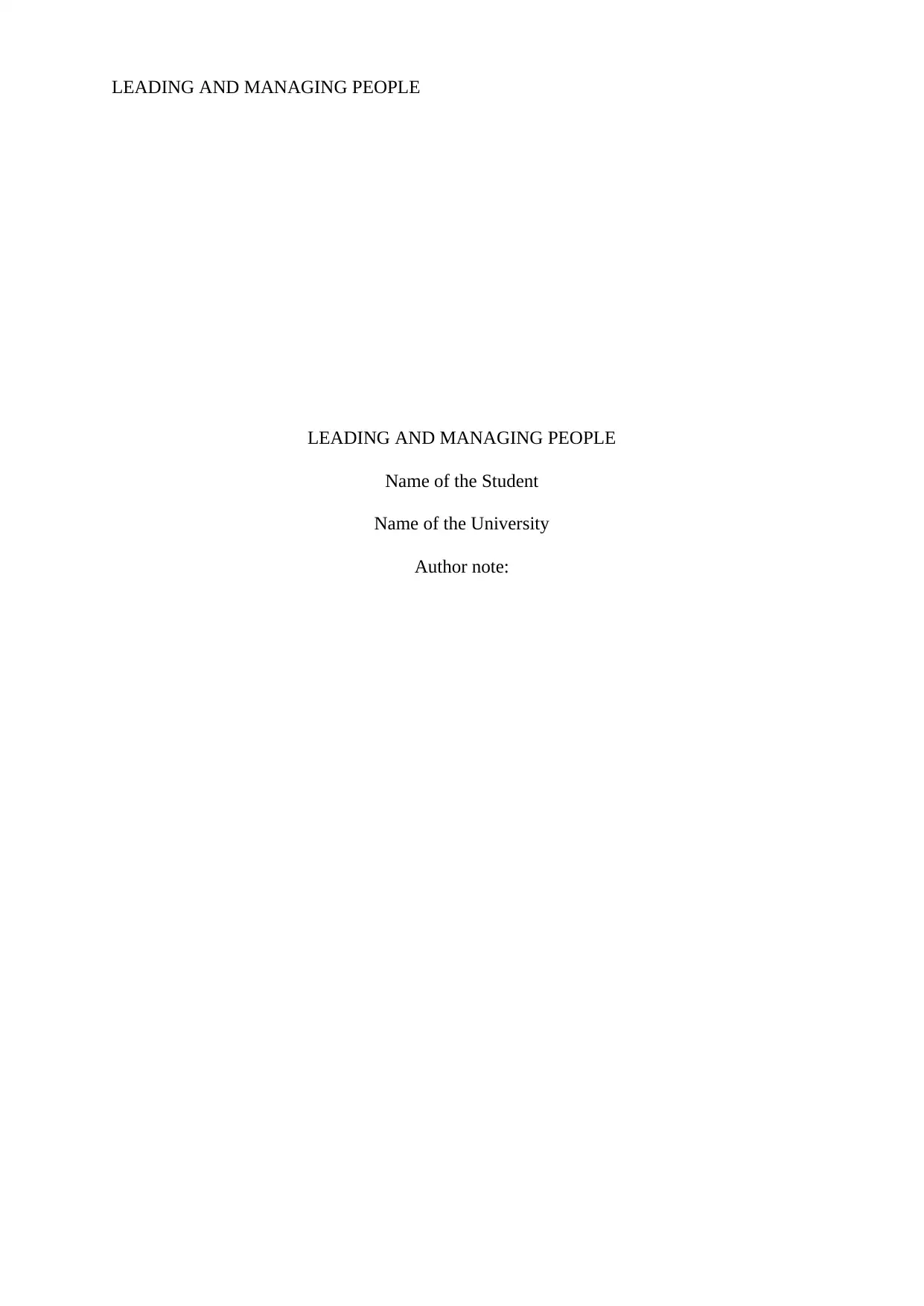
LEADING AND MANAGING PEOPLE
LEADING AND MANAGING PEOPLE
Name of the Student
Name of the University
Author note:
LEADING AND MANAGING PEOPLE
Name of the Student
Name of the University
Author note:
Paraphrase This Document
Need a fresh take? Get an instant paraphrase of this document with our AI Paraphraser
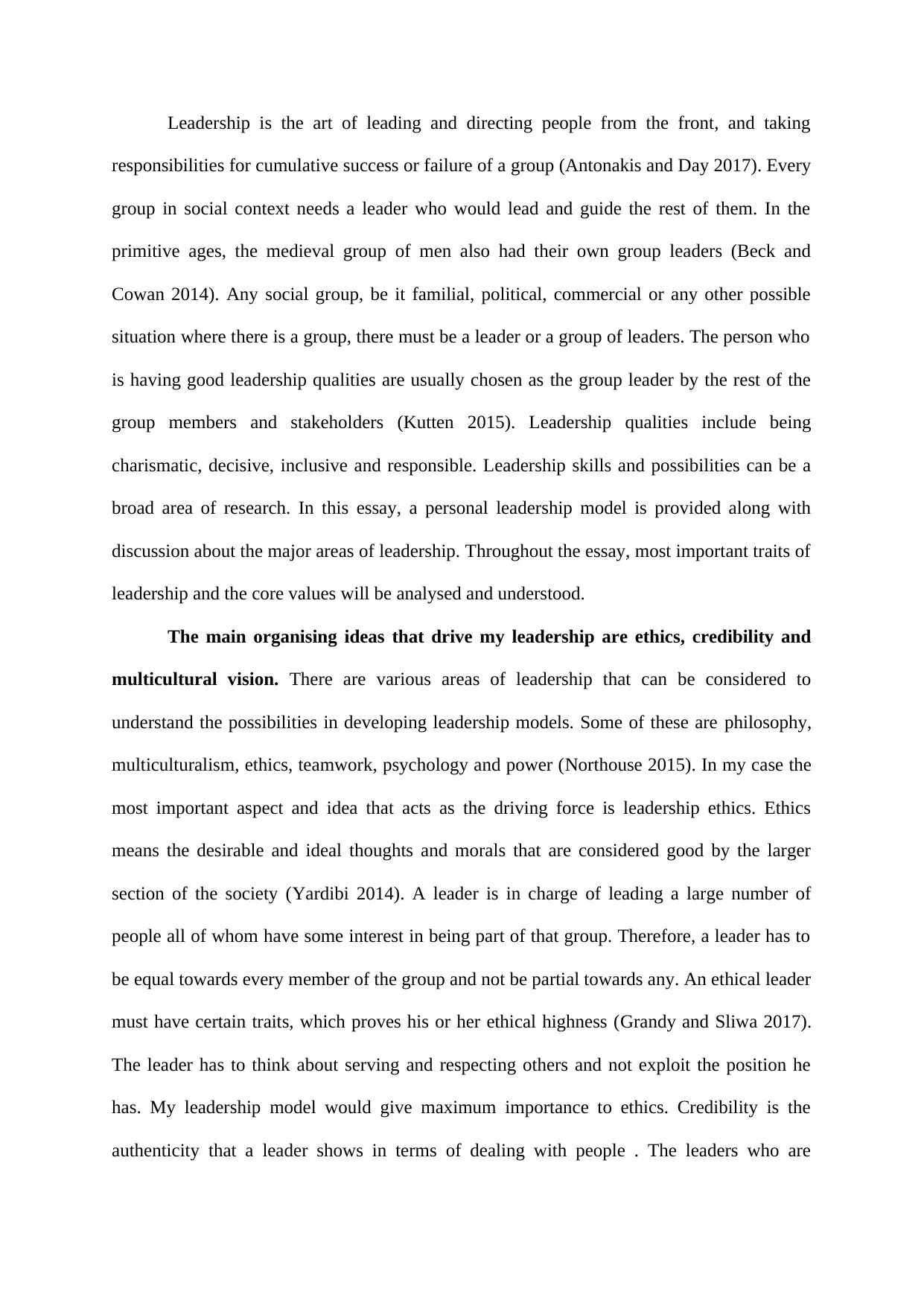
Leadership is the art of leading and directing people from the front, and taking
responsibilities for cumulative success or failure of a group (Antonakis and Day 2017). Every
group in social context needs a leader who would lead and guide the rest of them. In the
primitive ages, the medieval group of men also had their own group leaders (Beck and
Cowan 2014). Any social group, be it familial, political, commercial or any other possible
situation where there is a group, there must be a leader or a group of leaders. The person who
is having good leadership qualities are usually chosen as the group leader by the rest of the
group members and stakeholders (Kutten 2015). Leadership qualities include being
charismatic, decisive, inclusive and responsible. Leadership skills and possibilities can be a
broad area of research. In this essay, a personal leadership model is provided along with
discussion about the major areas of leadership. Throughout the essay, most important traits of
leadership and the core values will be analysed and understood.
The main organising ideas that drive my leadership are ethics, credibility and
multicultural vision. There are various areas of leadership that can be considered to
understand the possibilities in developing leadership models. Some of these are philosophy,
multiculturalism, ethics, teamwork, psychology and power (Northouse 2015). In my case the
most important aspect and idea that acts as the driving force is leadership ethics. Ethics
means the desirable and ideal thoughts and morals that are considered good by the larger
section of the society (Yardibi 2014). A leader is in charge of leading a large number of
people all of whom have some interest in being part of that group. Therefore, a leader has to
be equal towards every member of the group and not be partial towards any. An ethical leader
must have certain traits, which proves his or her ethical highness (Grandy and Sliwa 2017).
The leader has to think about serving and respecting others and not exploit the position he
has. My leadership model would give maximum importance to ethics. Credibility is the
authenticity that a leader shows in terms of dealing with people . The leaders who are
responsibilities for cumulative success or failure of a group (Antonakis and Day 2017). Every
group in social context needs a leader who would lead and guide the rest of them. In the
primitive ages, the medieval group of men also had their own group leaders (Beck and
Cowan 2014). Any social group, be it familial, political, commercial or any other possible
situation where there is a group, there must be a leader or a group of leaders. The person who
is having good leadership qualities are usually chosen as the group leader by the rest of the
group members and stakeholders (Kutten 2015). Leadership qualities include being
charismatic, decisive, inclusive and responsible. Leadership skills and possibilities can be a
broad area of research. In this essay, a personal leadership model is provided along with
discussion about the major areas of leadership. Throughout the essay, most important traits of
leadership and the core values will be analysed and understood.
The main organising ideas that drive my leadership are ethics, credibility and
multicultural vision. There are various areas of leadership that can be considered to
understand the possibilities in developing leadership models. Some of these are philosophy,
multiculturalism, ethics, teamwork, psychology and power (Northouse 2015). In my case the
most important aspect and idea that acts as the driving force is leadership ethics. Ethics
means the desirable and ideal thoughts and morals that are considered good by the larger
section of the society (Yardibi 2014). A leader is in charge of leading a large number of
people all of whom have some interest in being part of that group. Therefore, a leader has to
be equal towards every member of the group and not be partial towards any. An ethical leader
must have certain traits, which proves his or her ethical highness (Grandy and Sliwa 2017).
The leader has to think about serving and respecting others and not exploit the position he
has. My leadership model would give maximum importance to ethics. Credibility is the
authenticity that a leader shows in terms of dealing with people . The leaders who are
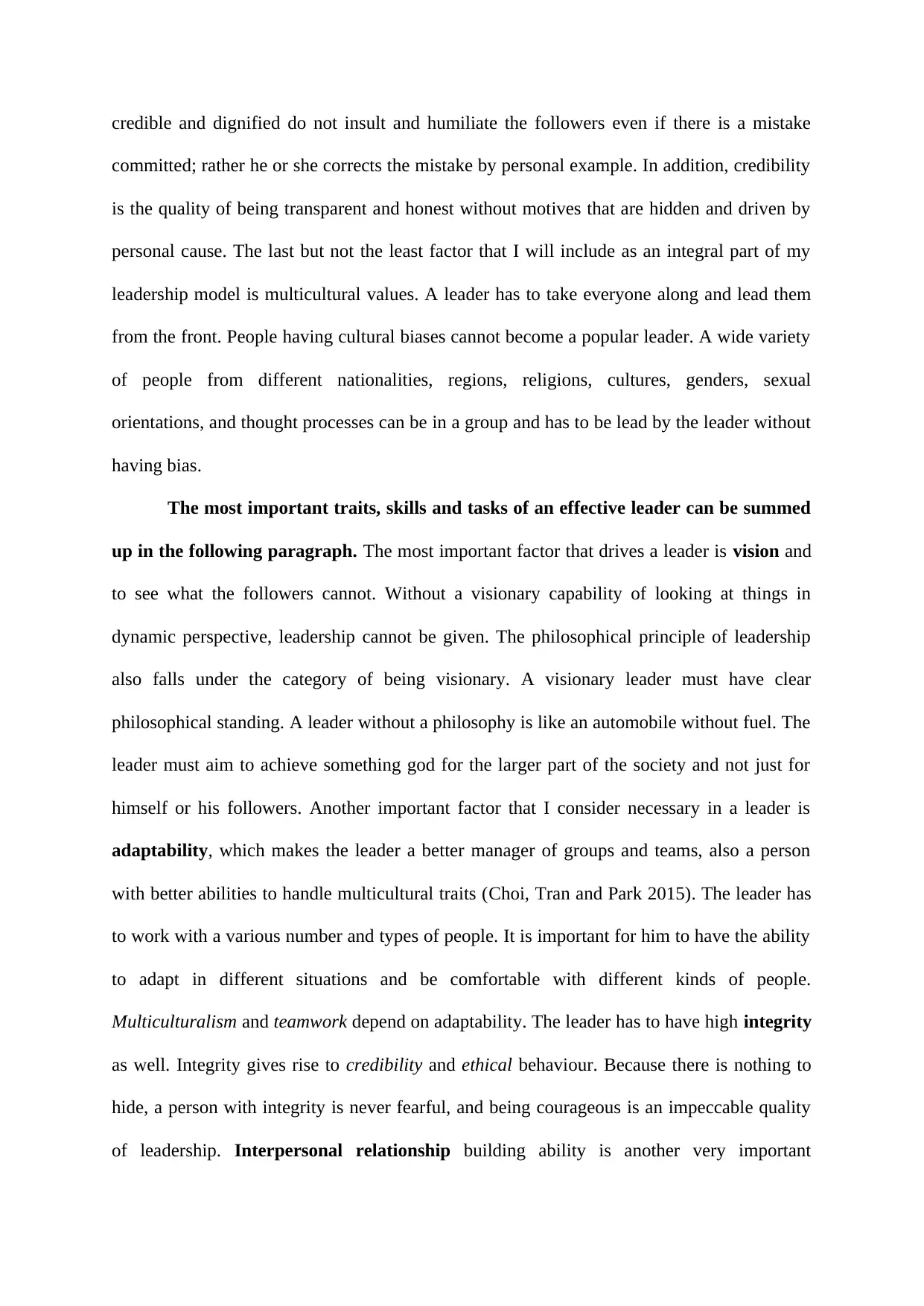
credible and dignified do not insult and humiliate the followers even if there is a mistake
committed; rather he or she corrects the mistake by personal example. In addition, credibility
is the quality of being transparent and honest without motives that are hidden and driven by
personal cause. The last but not the least factor that I will include as an integral part of my
leadership model is multicultural values. A leader has to take everyone along and lead them
from the front. People having cultural biases cannot become a popular leader. A wide variety
of people from different nationalities, regions, religions, cultures, genders, sexual
orientations, and thought processes can be in a group and has to be lead by the leader without
having bias.
The most important traits, skills and tasks of an effective leader can be summed
up in the following paragraph. The most important factor that drives a leader is vision and
to see what the followers cannot. Without a visionary capability of looking at things in
dynamic perspective, leadership cannot be given. The philosophical principle of leadership
also falls under the category of being visionary. A visionary leader must have clear
philosophical standing. A leader without a philosophy is like an automobile without fuel. The
leader must aim to achieve something god for the larger part of the society and not just for
himself or his followers. Another important factor that I consider necessary in a leader is
adaptability, which makes the leader a better manager of groups and teams, also a person
with better abilities to handle multicultural traits (Choi, Tran and Park 2015). The leader has
to work with a various number and types of people. It is important for him to have the ability
to adapt in different situations and be comfortable with different kinds of people.
Multiculturalism and teamwork depend on adaptability. The leader has to have high integrity
as well. Integrity gives rise to credibility and ethical behaviour. Because there is nothing to
hide, a person with integrity is never fearful, and being courageous is an impeccable quality
of leadership. Interpersonal relationship building ability is another very important
committed; rather he or she corrects the mistake by personal example. In addition, credibility
is the quality of being transparent and honest without motives that are hidden and driven by
personal cause. The last but not the least factor that I will include as an integral part of my
leadership model is multicultural values. A leader has to take everyone along and lead them
from the front. People having cultural biases cannot become a popular leader. A wide variety
of people from different nationalities, regions, religions, cultures, genders, sexual
orientations, and thought processes can be in a group and has to be lead by the leader without
having bias.
The most important traits, skills and tasks of an effective leader can be summed
up in the following paragraph. The most important factor that drives a leader is vision and
to see what the followers cannot. Without a visionary capability of looking at things in
dynamic perspective, leadership cannot be given. The philosophical principle of leadership
also falls under the category of being visionary. A visionary leader must have clear
philosophical standing. A leader without a philosophy is like an automobile without fuel. The
leader must aim to achieve something god for the larger part of the society and not just for
himself or his followers. Another important factor that I consider necessary in a leader is
adaptability, which makes the leader a better manager of groups and teams, also a person
with better abilities to handle multicultural traits (Choi, Tran and Park 2015). The leader has
to work with a various number and types of people. It is important for him to have the ability
to adapt in different situations and be comfortable with different kinds of people.
Multiculturalism and teamwork depend on adaptability. The leader has to have high integrity
as well. Integrity gives rise to credibility and ethical behaviour. Because there is nothing to
hide, a person with integrity is never fearful, and being courageous is an impeccable quality
of leadership. Interpersonal relationship building ability is another very important
⊘ This is a preview!⊘
Do you want full access?
Subscribe today to unlock all pages.

Trusted by 1+ million students worldwide
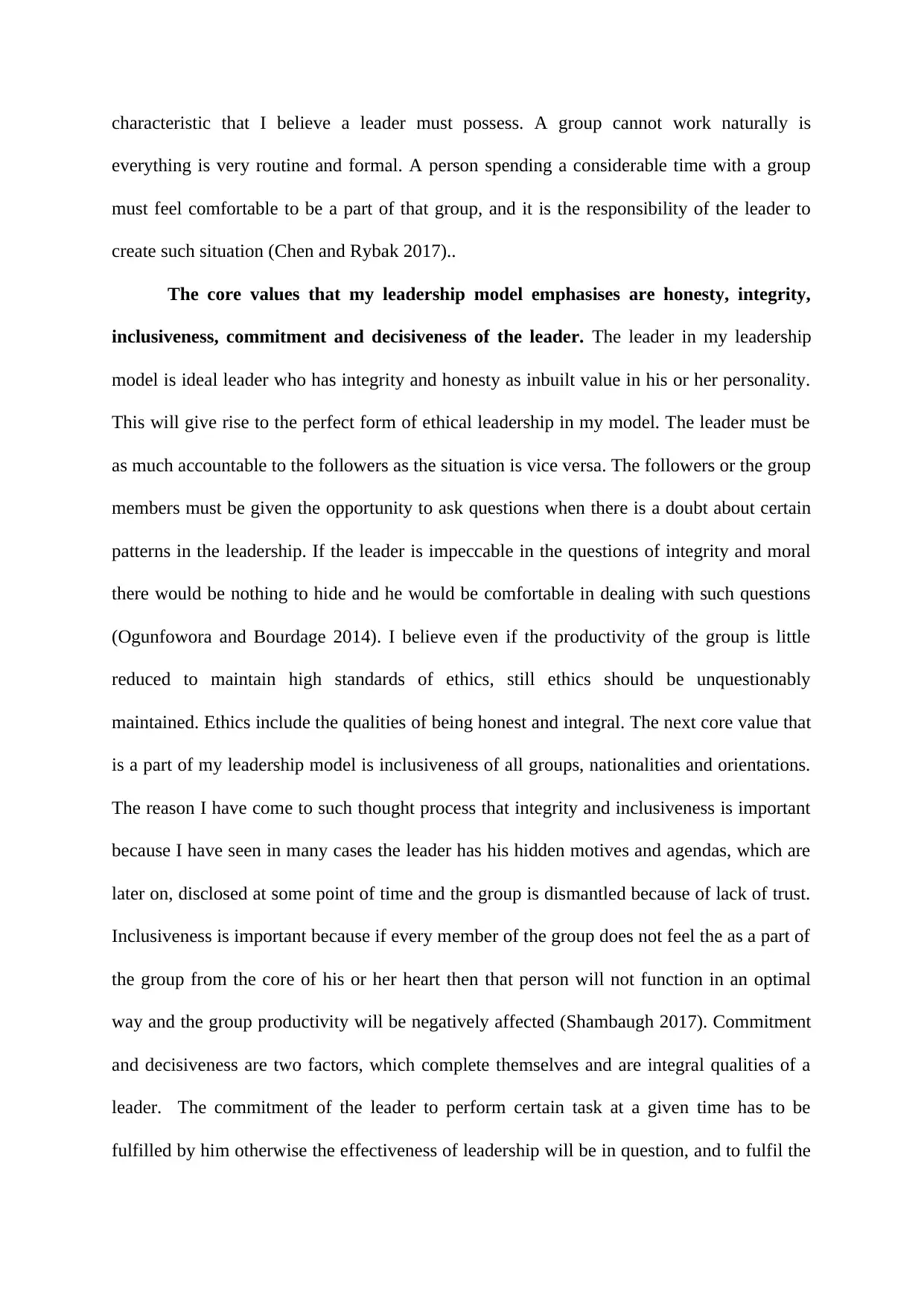
characteristic that I believe a leader must possess. A group cannot work naturally is
everything is very routine and formal. A person spending a considerable time with a group
must feel comfortable to be a part of that group, and it is the responsibility of the leader to
create such situation (Chen and Rybak 2017)..
The core values that my leadership model emphasises are honesty, integrity,
inclusiveness, commitment and decisiveness of the leader. The leader in my leadership
model is ideal leader who has integrity and honesty as inbuilt value in his or her personality.
This will give rise to the perfect form of ethical leadership in my model. The leader must be
as much accountable to the followers as the situation is vice versa. The followers or the group
members must be given the opportunity to ask questions when there is a doubt about certain
patterns in the leadership. If the leader is impeccable in the questions of integrity and moral
there would be nothing to hide and he would be comfortable in dealing with such questions
(Ogunfowora and Bourdage 2014). I believe even if the productivity of the group is little
reduced to maintain high standards of ethics, still ethics should be unquestionably
maintained. Ethics include the qualities of being honest and integral. The next core value that
is a part of my leadership model is inclusiveness of all groups, nationalities and orientations.
The reason I have come to such thought process that integrity and inclusiveness is important
because I have seen in many cases the leader has his hidden motives and agendas, which are
later on, disclosed at some point of time and the group is dismantled because of lack of trust.
Inclusiveness is important because if every member of the group does not feel the as a part of
the group from the core of his or her heart then that person will not function in an optimal
way and the group productivity will be negatively affected (Shambaugh 2017). Commitment
and decisiveness are two factors, which complete themselves and are integral qualities of a
leader. The commitment of the leader to perform certain task at a given time has to be
fulfilled by him otherwise the effectiveness of leadership will be in question, and to fulfil the
everything is very routine and formal. A person spending a considerable time with a group
must feel comfortable to be a part of that group, and it is the responsibility of the leader to
create such situation (Chen and Rybak 2017)..
The core values that my leadership model emphasises are honesty, integrity,
inclusiveness, commitment and decisiveness of the leader. The leader in my leadership
model is ideal leader who has integrity and honesty as inbuilt value in his or her personality.
This will give rise to the perfect form of ethical leadership in my model. The leader must be
as much accountable to the followers as the situation is vice versa. The followers or the group
members must be given the opportunity to ask questions when there is a doubt about certain
patterns in the leadership. If the leader is impeccable in the questions of integrity and moral
there would be nothing to hide and he would be comfortable in dealing with such questions
(Ogunfowora and Bourdage 2014). I believe even if the productivity of the group is little
reduced to maintain high standards of ethics, still ethics should be unquestionably
maintained. Ethics include the qualities of being honest and integral. The next core value that
is a part of my leadership model is inclusiveness of all groups, nationalities and orientations.
The reason I have come to such thought process that integrity and inclusiveness is important
because I have seen in many cases the leader has his hidden motives and agendas, which are
later on, disclosed at some point of time and the group is dismantled because of lack of trust.
Inclusiveness is important because if every member of the group does not feel the as a part of
the group from the core of his or her heart then that person will not function in an optimal
way and the group productivity will be negatively affected (Shambaugh 2017). Commitment
and decisiveness are two factors, which complete themselves and are integral qualities of a
leader. The commitment of the leader to perform certain task at a given time has to be
fulfilled by him otherwise the effectiveness of leadership will be in question, and to fulfil the
Paraphrase This Document
Need a fresh take? Get an instant paraphrase of this document with our AI Paraphraser
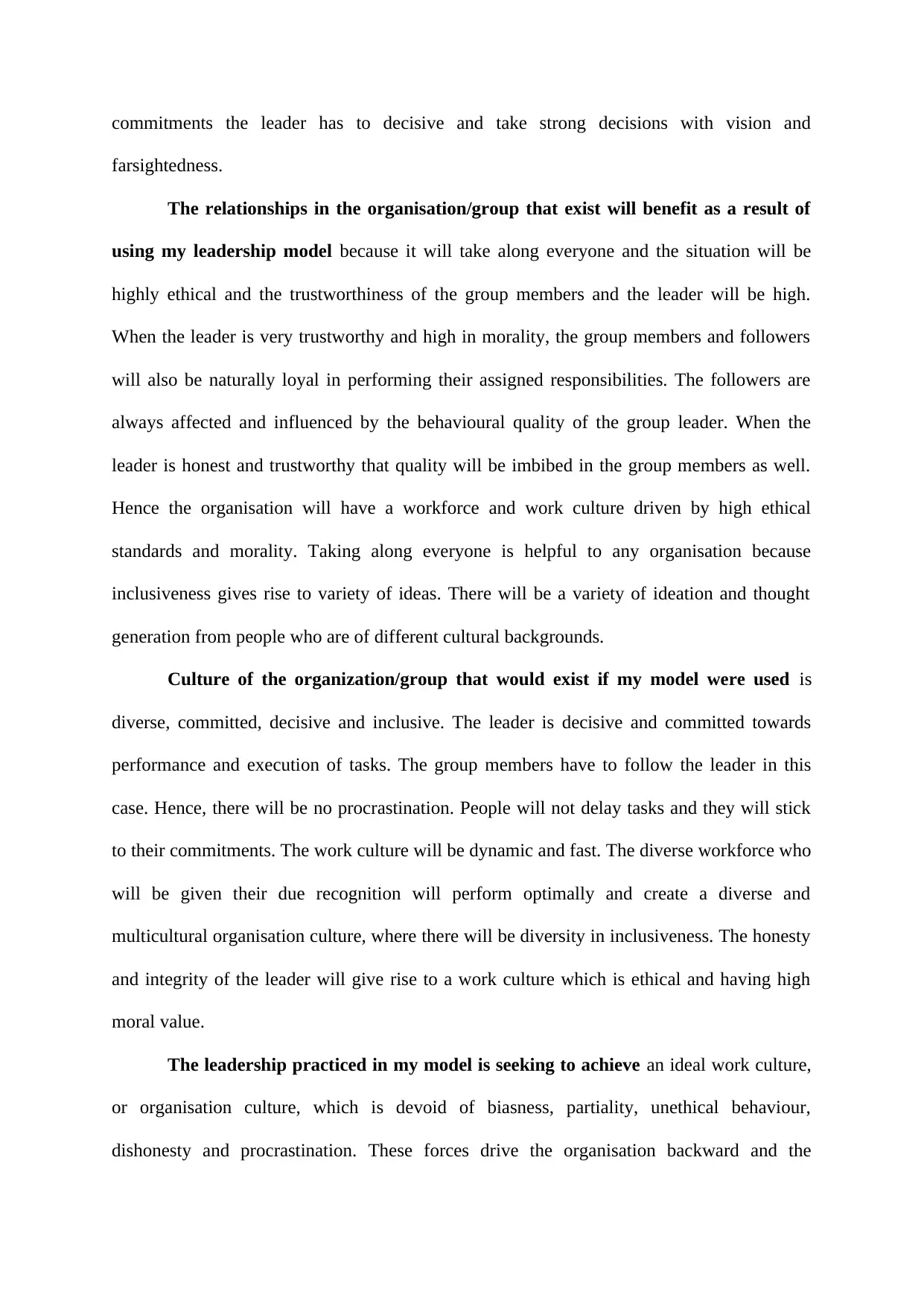
commitments the leader has to decisive and take strong decisions with vision and
farsightedness.
The relationships in the organisation/group that exist will benefit as a result of
using my leadership model because it will take along everyone and the situation will be
highly ethical and the trustworthiness of the group members and the leader will be high.
When the leader is very trustworthy and high in morality, the group members and followers
will also be naturally loyal in performing their assigned responsibilities. The followers are
always affected and influenced by the behavioural quality of the group leader. When the
leader is honest and trustworthy that quality will be imbibed in the group members as well.
Hence the organisation will have a workforce and work culture driven by high ethical
standards and morality. Taking along everyone is helpful to any organisation because
inclusiveness gives rise to variety of ideas. There will be a variety of ideation and thought
generation from people who are of different cultural backgrounds.
Culture of the organization/group that would exist if my model were used is
diverse, committed, decisive and inclusive. The leader is decisive and committed towards
performance and execution of tasks. The group members have to follow the leader in this
case. Hence, there will be no procrastination. People will not delay tasks and they will stick
to their commitments. The work culture will be dynamic and fast. The diverse workforce who
will be given their due recognition will perform optimally and create a diverse and
multicultural organisation culture, where there will be diversity in inclusiveness. The honesty
and integrity of the leader will give rise to a work culture which is ethical and having high
moral value.
The leadership practiced in my model is seeking to achieve an ideal work culture,
or organisation culture, which is devoid of biasness, partiality, unethical behaviour,
dishonesty and procrastination. These forces drive the organisation backward and the
farsightedness.
The relationships in the organisation/group that exist will benefit as a result of
using my leadership model because it will take along everyone and the situation will be
highly ethical and the trustworthiness of the group members and the leader will be high.
When the leader is very trustworthy and high in morality, the group members and followers
will also be naturally loyal in performing their assigned responsibilities. The followers are
always affected and influenced by the behavioural quality of the group leader. When the
leader is honest and trustworthy that quality will be imbibed in the group members as well.
Hence the organisation will have a workforce and work culture driven by high ethical
standards and morality. Taking along everyone is helpful to any organisation because
inclusiveness gives rise to variety of ideas. There will be a variety of ideation and thought
generation from people who are of different cultural backgrounds.
Culture of the organization/group that would exist if my model were used is
diverse, committed, decisive and inclusive. The leader is decisive and committed towards
performance and execution of tasks. The group members have to follow the leader in this
case. Hence, there will be no procrastination. People will not delay tasks and they will stick
to their commitments. The work culture will be dynamic and fast. The diverse workforce who
will be given their due recognition will perform optimally and create a diverse and
multicultural organisation culture, where there will be diversity in inclusiveness. The honesty
and integrity of the leader will give rise to a work culture which is ethical and having high
moral value.
The leadership practiced in my model is seeking to achieve an ideal work culture,
or organisation culture, which is devoid of biasness, partiality, unethical behaviour,
dishonesty and procrastination. These forces drive the organisation backward and the
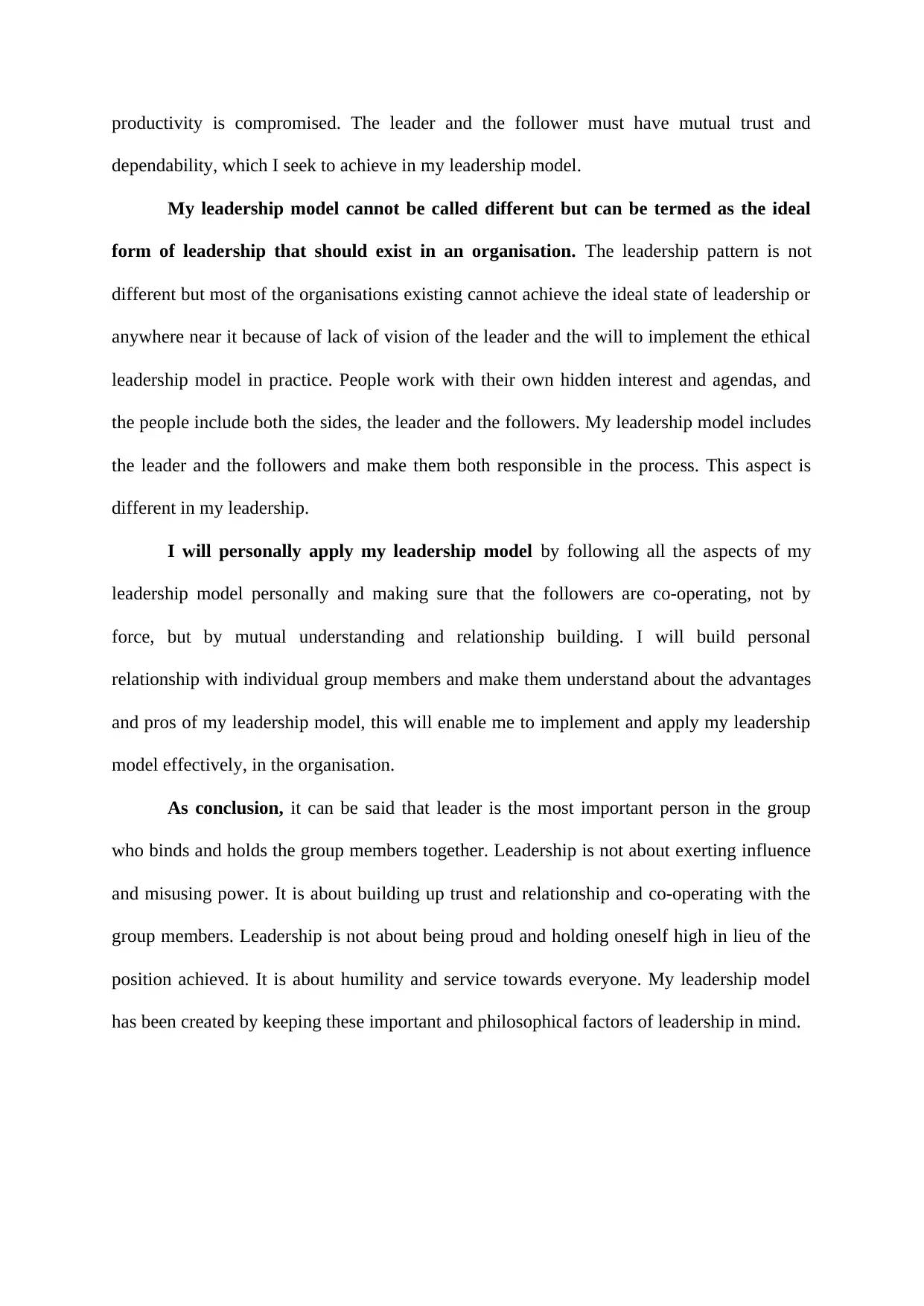
productivity is compromised. The leader and the follower must have mutual trust and
dependability, which I seek to achieve in my leadership model.
My leadership model cannot be called different but can be termed as the ideal
form of leadership that should exist in an organisation. The leadership pattern is not
different but most of the organisations existing cannot achieve the ideal state of leadership or
anywhere near it because of lack of vision of the leader and the will to implement the ethical
leadership model in practice. People work with their own hidden interest and agendas, and
the people include both the sides, the leader and the followers. My leadership model includes
the leader and the followers and make them both responsible in the process. This aspect is
different in my leadership.
I will personally apply my leadership model by following all the aspects of my
leadership model personally and making sure that the followers are co-operating, not by
force, but by mutual understanding and relationship building. I will build personal
relationship with individual group members and make them understand about the advantages
and pros of my leadership model, this will enable me to implement and apply my leadership
model effectively, in the organisation.
As conclusion, it can be said that leader is the most important person in the group
who binds and holds the group members together. Leadership is not about exerting influence
and misusing power. It is about building up trust and relationship and co-operating with the
group members. Leadership is not about being proud and holding oneself high in lieu of the
position achieved. It is about humility and service towards everyone. My leadership model
has been created by keeping these important and philosophical factors of leadership in mind.
dependability, which I seek to achieve in my leadership model.
My leadership model cannot be called different but can be termed as the ideal
form of leadership that should exist in an organisation. The leadership pattern is not
different but most of the organisations existing cannot achieve the ideal state of leadership or
anywhere near it because of lack of vision of the leader and the will to implement the ethical
leadership model in practice. People work with their own hidden interest and agendas, and
the people include both the sides, the leader and the followers. My leadership model includes
the leader and the followers and make them both responsible in the process. This aspect is
different in my leadership.
I will personally apply my leadership model by following all the aspects of my
leadership model personally and making sure that the followers are co-operating, not by
force, but by mutual understanding and relationship building. I will build personal
relationship with individual group members and make them understand about the advantages
and pros of my leadership model, this will enable me to implement and apply my leadership
model effectively, in the organisation.
As conclusion, it can be said that leader is the most important person in the group
who binds and holds the group members together. Leadership is not about exerting influence
and misusing power. It is about building up trust and relationship and co-operating with the
group members. Leadership is not about being proud and holding oneself high in lieu of the
position achieved. It is about humility and service towards everyone. My leadership model
has been created by keeping these important and philosophical factors of leadership in mind.
⊘ This is a preview!⊘
Do you want full access?
Subscribe today to unlock all pages.

Trusted by 1+ million students worldwide
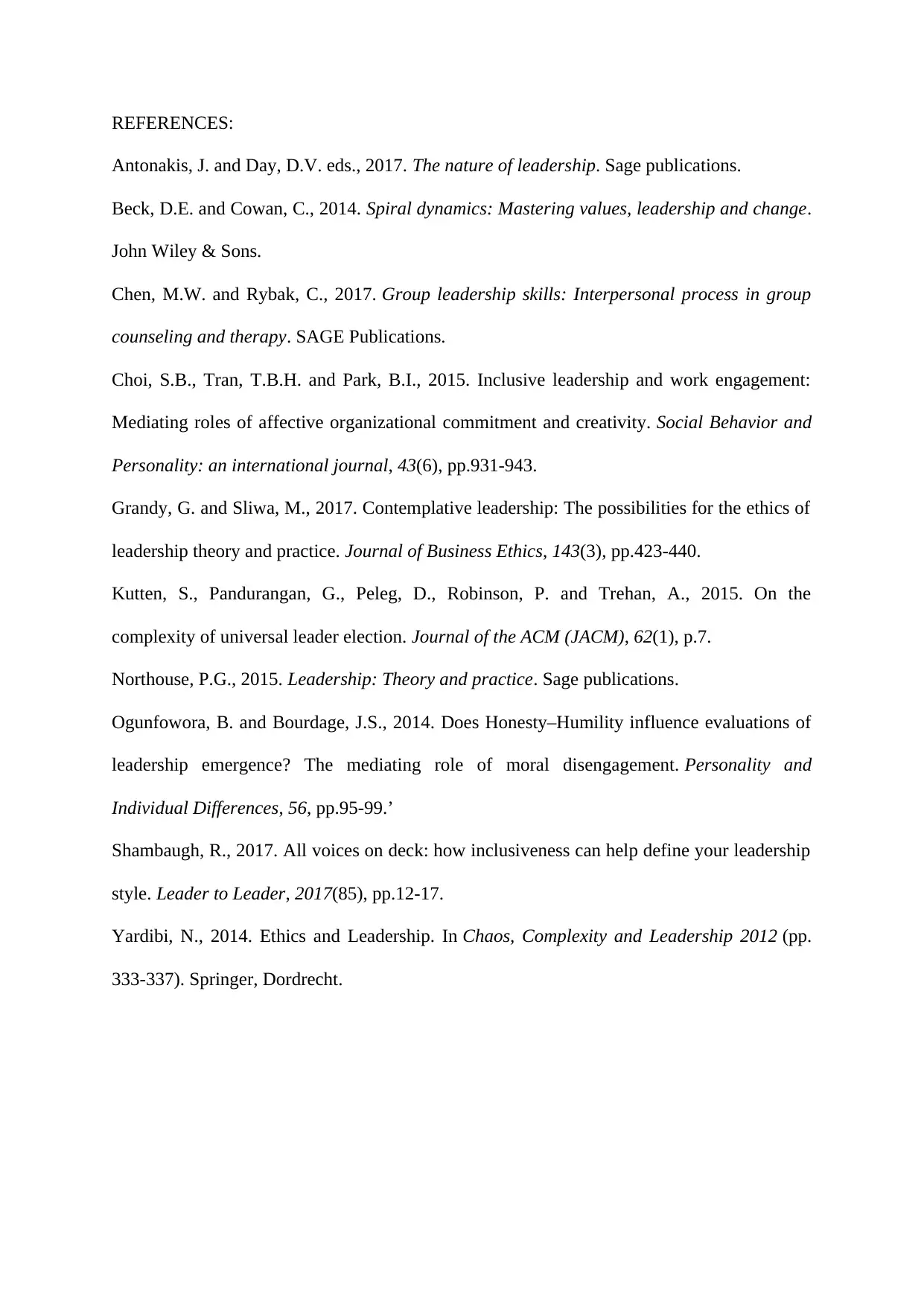
REFERENCES:
Antonakis, J. and Day, D.V. eds., 2017. The nature of leadership. Sage publications.
Beck, D.E. and Cowan, C., 2014. Spiral dynamics: Mastering values, leadership and change.
John Wiley & Sons.
Chen, M.W. and Rybak, C., 2017. Group leadership skills: Interpersonal process in group
counseling and therapy. SAGE Publications.
Choi, S.B., Tran, T.B.H. and Park, B.I., 2015. Inclusive leadership and work engagement:
Mediating roles of affective organizational commitment and creativity. Social Behavior and
Personality: an international journal, 43(6), pp.931-943.
Grandy, G. and Sliwa, M., 2017. Contemplative leadership: The possibilities for the ethics of
leadership theory and practice. Journal of Business Ethics, 143(3), pp.423-440.
Kutten, S., Pandurangan, G., Peleg, D., Robinson, P. and Trehan, A., 2015. On the
complexity of universal leader election. Journal of the ACM (JACM), 62(1), p.7.
Northouse, P.G., 2015. Leadership: Theory and practice. Sage publications.
Ogunfowora, B. and Bourdage, J.S., 2014. Does Honesty–Humility influence evaluations of
leadership emergence? The mediating role of moral disengagement. Personality and
Individual Differences, 56, pp.95-99.’
Shambaugh, R., 2017. All voices on deck: how inclusiveness can help define your leadership
style. Leader to Leader, 2017(85), pp.12-17.
Yardibi, N., 2014. Ethics and Leadership. In Chaos, Complexity and Leadership 2012 (pp.
333-337). Springer, Dordrecht.
Antonakis, J. and Day, D.V. eds., 2017. The nature of leadership. Sage publications.
Beck, D.E. and Cowan, C., 2014. Spiral dynamics: Mastering values, leadership and change.
John Wiley & Sons.
Chen, M.W. and Rybak, C., 2017. Group leadership skills: Interpersonal process in group
counseling and therapy. SAGE Publications.
Choi, S.B., Tran, T.B.H. and Park, B.I., 2015. Inclusive leadership and work engagement:
Mediating roles of affective organizational commitment and creativity. Social Behavior and
Personality: an international journal, 43(6), pp.931-943.
Grandy, G. and Sliwa, M., 2017. Contemplative leadership: The possibilities for the ethics of
leadership theory and practice. Journal of Business Ethics, 143(3), pp.423-440.
Kutten, S., Pandurangan, G., Peleg, D., Robinson, P. and Trehan, A., 2015. On the
complexity of universal leader election. Journal of the ACM (JACM), 62(1), p.7.
Northouse, P.G., 2015. Leadership: Theory and practice. Sage publications.
Ogunfowora, B. and Bourdage, J.S., 2014. Does Honesty–Humility influence evaluations of
leadership emergence? The mediating role of moral disengagement. Personality and
Individual Differences, 56, pp.95-99.’
Shambaugh, R., 2017. All voices on deck: how inclusiveness can help define your leadership
style. Leader to Leader, 2017(85), pp.12-17.
Yardibi, N., 2014. Ethics and Leadership. In Chaos, Complexity and Leadership 2012 (pp.
333-337). Springer, Dordrecht.
1 out of 7
Related Documents
Your All-in-One AI-Powered Toolkit for Academic Success.
+13062052269
info@desklib.com
Available 24*7 on WhatsApp / Email
![[object Object]](/_next/static/media/star-bottom.7253800d.svg)
Unlock your academic potential
Copyright © 2020–2025 A2Z Services. All Rights Reserved. Developed and managed by ZUCOL.





